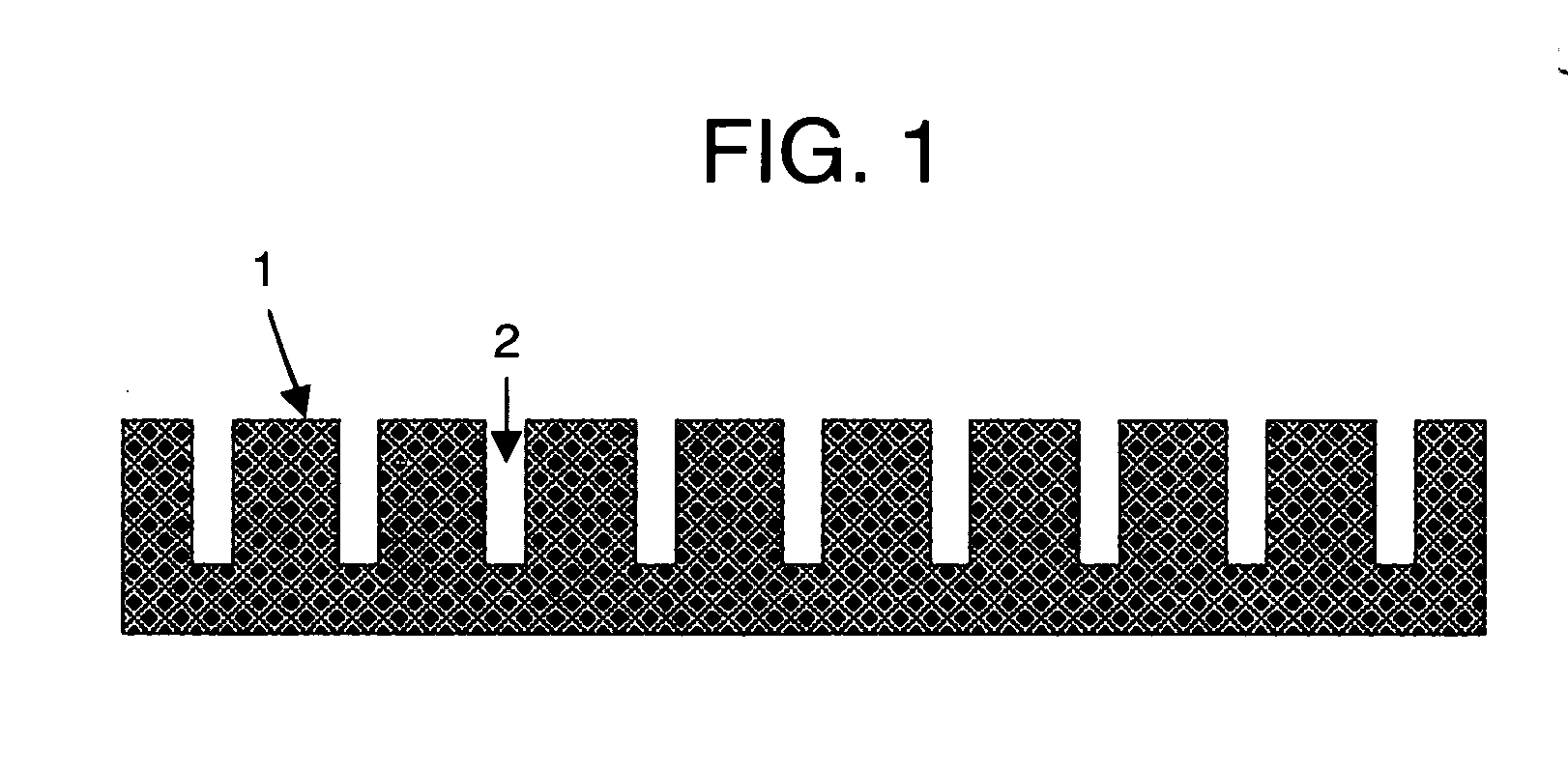Polishing pad process for producing the same and method of polishing
a technology of polishing pad and process, which is applied in the field of polishing pads, can solve the problems of short life of polishing pads, difficulty in producing uniform products throughout polishing pads, and difficulty in producing uniform products, etc., and achieves high planarizing ability, high polishing speed, and high uniformity of polishing.
- Summary
- Abstract
- Description
- Claims
- Application Information
AI Technical Summary
Benefits of technology
Problems solved by technology
Method used
Image
Examples
example 1
[0071] A fabric comprising a nonwoven fabric (“Shaleria” manufactured by Asahikasei K. K.) with a thickness of 1 mm comprising a porous acrylic fiber having a tensile strength at dry of 3.1 g / D, a shape irregularity ratio of 1.5 and a moisture content of 1.2% was impregnated with a photo-sensitive resin composition comprising a unsaturated polyester oligomer 65% by weight, a hydroxyl group-containing monofunctional monomer 17% by weight, another monomer 16% by weight and a photo polymerization initiator 2% by weight, and then an ultraviolet ray was irradiated from both sides to prepare a polishing pad with a thickness of 1.5 mm and a diameter of 50 cm. The area ratio of fabric of 35%, a water absorption of 5.6% and a porosity (a value calculated for the region excluding the fabric in the polishing pad) of 2.0%.
[0072] After creating grooves for slurry transport by machining, the polishing pad was mounted to the CMP polisher, and the mean polishing speed of the copper film on the sil...
example 2
[0073] A fabric comprising a nonwoven fabric (“ColdonR0260T” manufactured by Asahikasei K. K.) with a thickness of 1 mm comprising a rayon fiber having a tensile strength at dry of 2.1 g / D, a shape irregularity ratio of 1.2 and a moisture content of 21.3% was impregnated with a photo-sensitive resin composition as in Example 1, and then an ultraviolet ray was irradiated from both sides to prepare a polishing pad with a thickness of 1.5 mm and a diameter of 50 cm. The area ratio of fabric of 13%, a water absorption of 7.3% and a porosity (a value calculated for the region excluding the fabric in the polishing pad) of 0.1% or less.
[0074] After creating grooves for slurry transport by machining, the polishing pad was mounted to the CMP polisher, and the mean polishing speed of the copper film on the silicon wafer was determined using a slurry of silica abrasive grains to obtain a polishing speed of 660 nm / min at the maximum. Also, the amount of abrasion of the pad was determined to be...
example 3
[0075] A photo-sensitive resin composition was prepared in the following procedure.
[0076] (A) To an unsaturated polyester with a molecular weight of 2400 that was synthesized by a usual polycondensation reaction at a ratio of one mole part of diethylene glycol, 0.5 mole part of adipic acid and 0.5 mole part of fumaric acid, di-N-butyltin laurate was added as an urethanation catalyst, and then 6.3% of 2-isocyanatoethyl methacrylate at a weight ratio to the above polyester was added dropwise under stirring to perform urethanation treatment. As used herein the above urethanation catalyst was added to 5% in a weight ratio to 2-isocyanatoethyl methacrylate.
[0077] (B) To 3-methyl-1,5-pentanediol, di-N-butyltin laurate was added as an urethanation catalyst, and then two mole part (2.6-fold amount on a weight ratio) of 2-isocyanatoethyl methacrylate to one mole part of the above diol was added dropwise under stirring to perform urethanation treatment. As used herein the above urethanation...
PUM
| Property | Measurement | Unit |
|---|---|---|
| RH | aaaaa | aaaaa |
| thickness | aaaaa | aaaaa |
| mean size | aaaaa | aaaaa |
Abstract
Description
Claims
Application Information
 Login to View More
Login to View More - R&D
- Intellectual Property
- Life Sciences
- Materials
- Tech Scout
- Unparalleled Data Quality
- Higher Quality Content
- 60% Fewer Hallucinations
Browse by: Latest US Patents, China's latest patents, Technical Efficacy Thesaurus, Application Domain, Technology Topic, Popular Technical Reports.
© 2025 PatSnap. All rights reserved.Legal|Privacy policy|Modern Slavery Act Transparency Statement|Sitemap|About US| Contact US: help@patsnap.com


